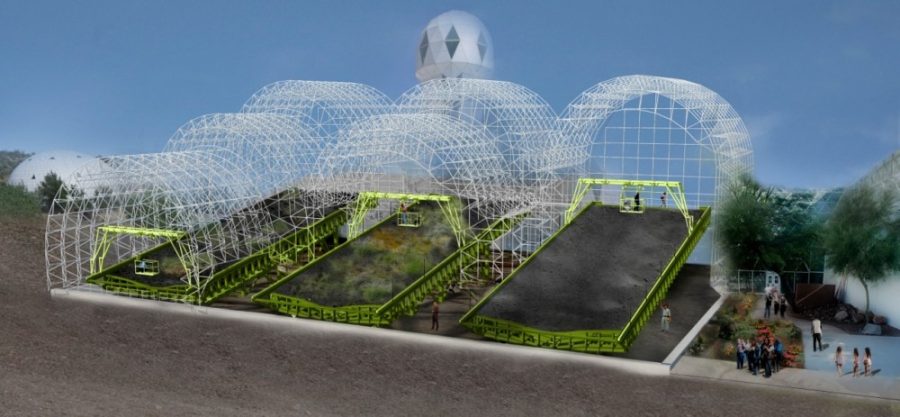The UA’s Biosphere 2 is making room for the Landscape Evolution Observatory, a one-of-a-kind research tool that will further the study of several earth processes.
The observatory will consist of three massive hill slopes meant to simulate those found in natural landscapes. By studying the water run-off, researchers can use the model to monitor how ecological, hydrological and geological processes interact. This research will greatly contribute to the understanding of earth’s climate change, according to Hassan Hijazi, external affairs director at Biosphere 2.
The project requires contributions from seven different science departments, including the Department of Hydrology and Water Resources, the Department of Geosciences and the Department of Atmospheric Sciences. Each of which will lead different aspects of the project.
Each hill slope in the observatory is 40 feet wide by 100 feet long and weighs more than two million pounds. The soil making up each slope fits into three large steel trays, which will sit at an angle atop a large concrete base.
“These things are sitting on 10 steel columns,” said Stephen DeLong, assistant research professor at Biosphere 2 and the lead scientist for the new project. “The reason they’re on columns is because they actually sit right on top of some existing concrete columns that are in the basement of the facility. All the weight is transferred through that.”
The soil itself is composed of volcanic rock from Merriam Crater, a volcano 30 miles northeast of Flagstaff that last erupted sometime within the last 100,000 years. Since the eruption, the rock’s composition has not changed much, leaving it with a texture that allows water to pass through the soil at a perfect rate for measurement.
DeLong said it was necessary to take materials from Flagstaff because of their chemical makeup. The rocks contain minerals such as olivine and feldspar that are susceptible to chemical weathering.
Additionally, each hill slope will be equipped with more than 1,000 sensors lodged into the soil, which will be used to measure things like water concentration, soil temperature, levels of carbon dioxide and heat flux throughout the landscape. The steel structures will use similar sensors to measure the weight of the landscapes, allowing scientists to monitor and balance the water budget as they add water to the slopes.
The physical planning and design for the project started about a year and a half ago, but the idea for a project of this type has existed since before the UA’s acquisition of Biosphere 2 in 2007.
“We have been planning this experiment since 2006,” said Travis Huxman, Biosphere 2 director. “It was conceived by our steering committee … who ran a series of workshops aimed at developing the design over the last five to six years.”
The project is now in the construction stage, which started last week, and the steel construction portion is currently two-thirds complete, according to DeLong. The observatory will occupy the area that previously housed vegetation growth when the original proprietors ran Biosphere 2. M3 Engineering of Tucson is leading the design and construction processes. The completion of the project is expected by early 2012.
Funding for the $7 million project comes from several sources, including the original $30 million budget from the Philecology Foundation, which gave Biosphere 2 to the UA. According to Hijazi, additional funding will come from several grants.
“Many scientists from across the world will be interested in this particular project,” Hijazi added. “They can conduct their research from inside the facility, and they can monitor the information and the data from their lab or from their university anywhere in the world. This will also bring another source of revenue to the university when we explore these collaborations.”
From a research perspective, DeLong is also optimistic about what the project will bring to the UA.
“This research really gets at some of the core strengths of the University of Arizona,” he said. “This gives us a new tool … for graduate students and undergraduate students to get involved in. It really sets the U of A apart from other universities in that large scale, earth science infrastructure experiments are very rare. This is really a one-of-a-kind thing.”
Opening new doors to other areas of research was also a primary focus, according to Huxman.
“This was our main interest in taking on B2,” he said. “The idea is that this experiment moves us into a leadership role in the field and opens doors to being able to ask big questions.”
Click here to view a timelapse video of some construction for the project.









